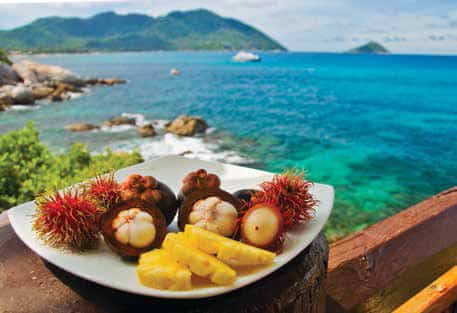The Hawaiian Islands Are Incomparably Delicious
In island communities, ingredients, flavors and cooking techniques of indigenous peoples and visitors mingle to form a local food culture unique to the locale. In Hawai'i, early Polynesians, European whalers, American missionaries, East Asian sugar-plantation workers and recent immigrants from throughout the world have left their mark on a vibrant and delicious food scene.
Seeds from many lands have produced an eclectic mix of fruits and vegetables in a tropical climate. The Pacific Ocean provides a cornucopia of fresh fish and seafood. Farmers and ranchers continue a rich tradition of food production. Add some creative contemporary chefs, out comes a cuisine, rich in culinary traditions, that is no longer just Chinese, French, Japanese, American, Korean or Portuguese, but rather a melding that is uniquely Hawaiian.
Try Fresh Fish and Poke
Fish is Hawai'i's premier protein, freshly caught in surrounding Pacific waters and expertly handled by fishermen and purveyors. Yellowfin and big-eye ahi (tuna) are prized, especially in raw preparations, but equally important in island cuisine are mahimahi, monchong, 'ōpakapaka, onaga, swordfish and marlin. Steamed, grilled or sautéed, sauced with beurre blanc, or drizzled with soy sauce and ginger, Hawai'i's fish is unrivaled.
Especially cherished is poke, the ubiquitous pūpū (appetizer) frequently nibbled on with a cold beer or glass of wine. Fresh bite-size morsels of raw fish — primarily ahi — are seasoned with 'inamona (ground candlenut), soy sauce, kochu jang (Korean chili paste) or countless other ways. It's available everywhere fish is sold and served; find top-notch versions at Fish Express in Lihue, Kaua'i; Fort Ruger Market and Tamashiro in Honolulu, O'ahu; Lana'i Ohana Poke Market in Lana'i; and Sam Choy's Kai Lanai in Keauhou, Hawai'i Island, where fried poke is a signature dish.
Eat Like A Local In The Islands
Local food, also known as local grindz, is Hawai'i's everyday food. Served at mom-and-pop venues, food trucks and fast-food joints, it's not fancy or elegant. Most notable is the plate lunch: two scoops of rice (steamed, white and sticky), mac salad (a mayonnaise-laden macaroni concoction) and a hefty portion of protein that's either teriyaki beef or chicken; pork or chicken katsu (breaded and fried); furikake (seasoned seaweed) fish; kalbi (Korean short ribs), beef curry; or stew. Home-style island cooking defines the plate lunch.
Upscale plate lunches at Honolulu's Diamond Head Market & Grill are also popular. Hawai'i Island's Hawaiian Style Cafe (one in Waimea, one in Hilo) gets high marks, as do Sam Sato's, Wailuku, Maui and Ono Family Restaurant in Kapa'a, Kaua'i.
In Honolulu, on the last Friday of each month, is Eat the Street, a rally of food trucks offering an international array of plate lunches during the dinner hour. Go to eatthestreethawaii.com for location and schedule.
Eating local also means eating from the 'āina (land), a top-of-mind attitude in Hawaii. There's no better place than Village Burger in Waimea on Hawai'i Island, where beef is freshly ground and sourced from island ranchers, and mushrooms, taro, vegetables, milk and ice cream are sourced from local farms. The farm-to-table concept is taken literally here.
"Local Grinds" At Its Finest
Top Hawai'i chefs recognize the tasty, bold flavors of local grindz and enhance them with haute cooking techniques and the freshest of locally grown ingredients, a style known as Hawaii regional cuisine. The venerable James Beard-award-winning restaurants — Roy's, Alan Wong's and Chef Mavro — are still among the best, and notable venues 3660 on the Rise, Hoku's, Sansei, Orchids, Hali'imaile General Store, Merriman's and Town rarely disappoint.
New ingredients, chefs, restaurants and ideas constantly fuel the food buzz throughout the state. MW in Honolulu is racking up winning reviews for its riff on classic savory and sweet dishes from "small kid time" Hawai'i. Also on O'ahu, 12th Avenue Grill, The Pig and the Lady, and Monkeypod are favored for their home-style, well-executed comfort foods in casual settings. The Moon and Turtle in Hilo is a bright spot on Hawai'i Island, with a daily menu based on farmers-market finds. On Maui, Mala (locations in Lahaina and Wailea) offers exceptionally fresh and simple preparations that will delight the taste buds.
Hawai'i's Farmers Markets Are A Saturday Affair
Hawai'i's farmers markets are booming, and you'll find one every Saturday morning on Kaua'i, O'ahu, Maui, Lana'i, Moloka'i and Hawai'i Island. Expect to see exotic tropical fruit like mangosteen, durian, carambola, lychee, dragon fruit, guava, pohā, liliko'i, rambutan and cherimoya. Papaya, pineapple, apple bananas, avocados and mangoes (in season) are always on hand, picked at the peak of flavor. Amazing too is the wide assortment of herbs and vegetables: wing beans, long eggplant, choy sum, bok choy, pipinola, hearts of palm, mesclun, tomatoes, sea asparagus, breadfruit, taro and purple sweet potato.
Farmers markets are the best place to find edibles to take home: fresh roasted maca- damia nuts, honey, dehydrated fruit and preserves, and Hawai'i-grown vanilla, coffee and chocolates.
It goes without saying that farmers mar- kets are a community event where residents shop for fresh ingredients while trading cooking tips with each other and farmers too. And you should go to a farmers market hungry — tasty prepared foods will give you a taste of the local food culture. For a listing of farmers markets, go to hdoa.hawaii.gov/add/md/farmers-market-listings.
As a string of islands in the middle of the Pacific, Hawai'i has an incomparable food scene reflecting the many ethnicities that have come to its shores. The state's artisanal farmers, ranchers, chefs, bakers and food specialists contribute to a cuisine that's simply ono (delicious).
